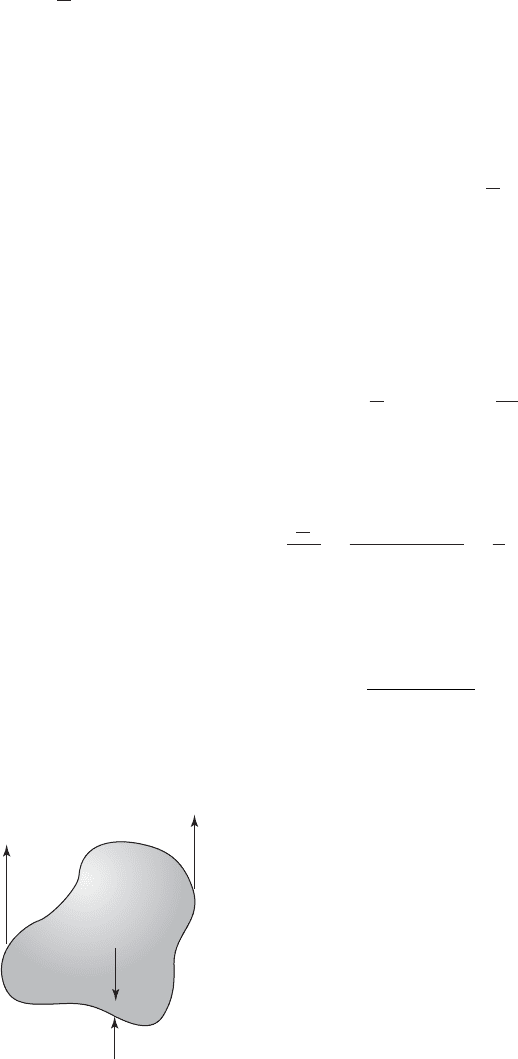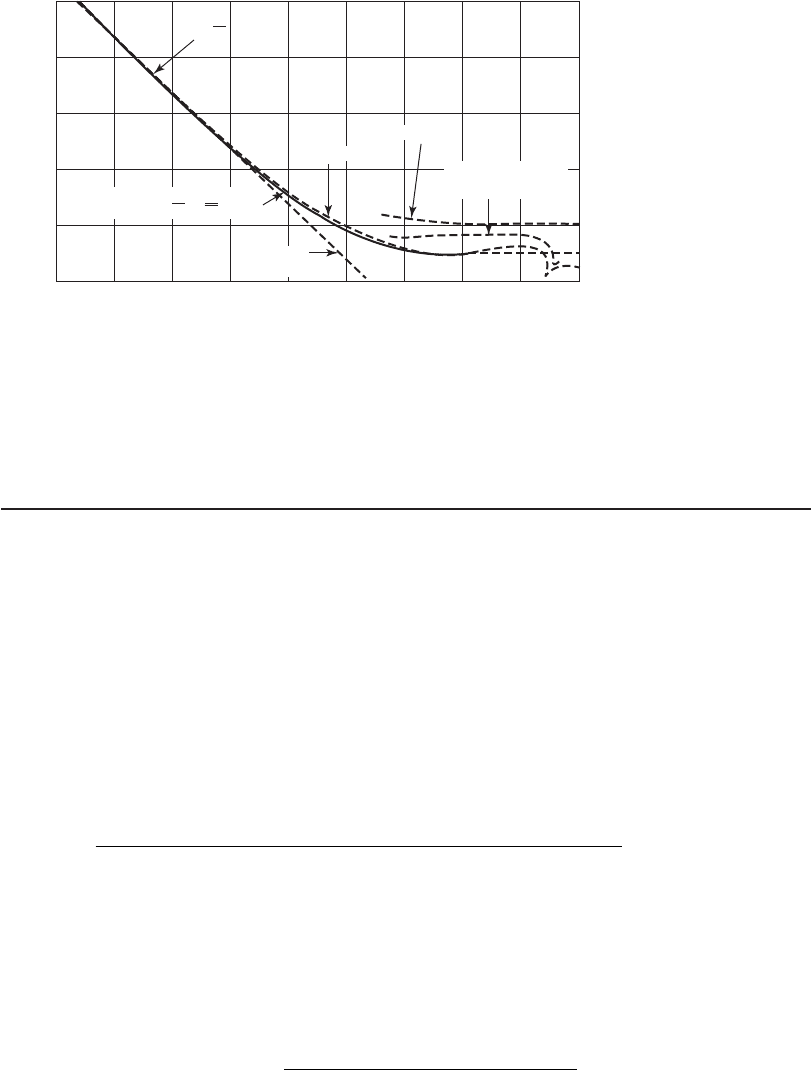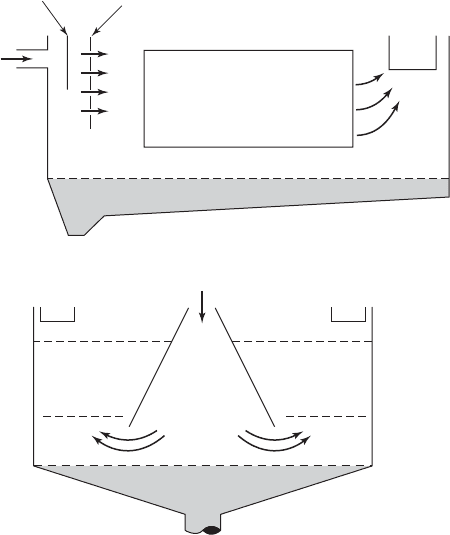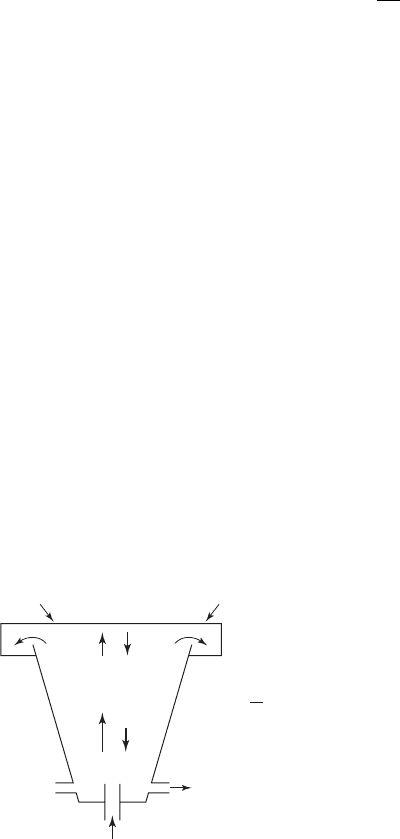Water and Wastewater Engineering
Подождите немного. Документ загружается.

REVERSE OSMOSIS AND NANOFILTRATION 9-21
Masters, G. M. (1998) Introduction to Environmental Engineering and Science, Prentice Hall, Upper
Saddle River, New Jersey, p. 59.
MWH (2005) Water Treatment: Principles and Design, John Wiley & Sons, Hoboken, NJ, pp. 1445,
1472, 1564.
Robinson, R. A. and R. H. Stokes (1959) Electrolyte Solutions: the Measurement and Interpretation of
Conductance, Chemical Potential, and Diffusion in Solutions of Simple Electrolytes, Butterworths,
London.
Taylor, J. S. and M. Wiesner (1999) Membranes, in R. D. Letterman (ed.) Water Quality and Treatment,
5th ed., American Water Works Association, McGraw-Hill, New York, pp. 11.1–11.71.
U.S. AID (1980) The U.S. Agency for International Development Desalinization Manual, Denver,
Colorado.
U.S. EPA (2005) Membrane Guidance Manual, U.S. Environmental Protection Agency, Washington,
D.C., pp. 7-7–7-8.

10-1
10-6 CHAPTER REVIEW
10-7 PROBLEMS
10-8 DISCUSSION QUESTIONS
10-9 REFERENCES
SEDIMENTATION
10-1 INTRODUCTION
10-2 SEDIMENTATION THEORY
10-3 SEDIMENTATION PRACTICE
10-4 SEDIMENTATION BASIN DESIGN
10-5 OPERATION AND MAINTENANCE
10
CHAPTER

10-2 WATER AND WASTEWATER ENGINEERING
10-1 INTRODUCTION
One of the objectives of the coagulation and flocculation processes is to enhance the size of
particles so that they will settle in a reasonable period of time. The lime-soda softening process
objective is to remove hardness by forming an insoluble precipitate. Once the particles and pre-
cipitate are formed, the most common means
of removing them from the water is by gravitational
settling in a sedimentation basin (also called a clarifier or settling tank ). Other means, such as
direct filtration or flotation, may also be employed. Gravitational settling is the subject of this
chapter. The other processes are described in Chapters 11, 15, and 27.
10-2 SEDIMENTATION THEORY
In the design of an ideal sedimentation tank, one of the controlling parameters is the settling
velocity ( v
s
) of the particle to be removed. For the purpose of discussion and illustration, the set-
tling properties of particles are categorized into four classes: (1) discrete particle settling, (2) floc-
culant settling, (3) hindered settling, and (4) compression settling. By convention these categories
have been labeled Type I, Type II, Type III, and Type IV
settling, respectively. In actual settling
tanks, it is not uncommon to see all of these types of settling. The value of separating the discus-
sion into these categories is that it provides a means of understanding the relationship between
variables in the design of the sedimentation basin.
Type I Sedimentation
T ype I sedimentation is characterized by particles that settle discretely at a constant settling
velocity. They settle as individual particles and do not flocculate during s ettling. Examples of
these particles are sand and grit (a mixture of abrasive partic
les that may include sand, broken
glass, etc.). Generally speaking, the only applications of Type I settling are during presedimenta-
tion for sand removal prior to coagulation in a potable water plant, in settling of sand particles
during cleaning of rapid sand filters, and in grit chambers.
Stokes’ Law. When particles settle discretely, the partic
le settling velocity can be calculated,
and the basin can be designed to remove a specific size particle. In 1687, Sir Isaac Newton showed
that a particle falling in a quiescent fluid accelerates until the frictional resistance, or drag, on the
particle is equal to the gravitational force of the particle ( Figure 10-1 ) (Newton, 1687). The three
forces are defined as
follows:
Fg
Gs
p
()
V
(10-1)
Fg
B
p
()
V
(10-2)
FCA
v
DDp
()
2
2
(10-3)
where F
G
gravitational force
F
B
buoyancy force
F
D
drag force
s
density of particle, kg/m
3
density of fluid, kg/m
3

SEDIMENTATION 10-3
g acceleration due to gravity, m/s
2
P
volume
V
of particle, m
3
C
D
drag coefficient
A
p
cross-sectional area of particle, m
2
v velocity of particle, m/s
The driving force for acceleration of the particle is the differenc e between the gravitational and
buoyant forces:
FF g
GB s
p
()
V
(10-4)
When the drag force is equal to the driving force, the particle velocity reaches a constant value
called the terminal settling velocity ( v
s
).
FF F
GB D
(10-5)
() ()
s
p
Dp
g CA
v
2
2
V
(10-6)
For spherical particles with a diameter d,
p
p
A
d
d
d
4 3 2
2
2
3
3
2
//
/
()( )
()( )
V
(10-7)
U sing Equations 10-6 and 10 -7 to solve for the terminal settling velocity:
v
gd
C
s
s
D
4
3
12
()
/
⎡
⎣
⎢
⎤
⎦
⎥
(10-8)
F
D
F
D
F
G
F
B
FIGURE 10-1
Forces acting on a free-falling particle in a fluid ( F
D
drag force; F
G
gravitational
force; F
B
buoyancy force). ( Source: Davis and Cornwell, 2008.)

10-4 WATER AND WASTEWATER ENGINEERING
The drag coeffic ient takes on different values depending on the flow regime surrounding the
particle. The flow regime may be characterized qualitatively as laminar, turbulent, or transi-
tional. In laminar flow, the fluid moves in layers, or laminas, with one layer gliding smoothly
over adjacent layers with only molecular interc
hange of momentum. In turbulent flow, the
fluid m otion is very erratic with a violent transverse interchange of mom entum. Osborne
Reynolds (1883) developed a qu antitative means of describing the different flow regimes using
a dimensionless ratio that is called the Reynolds number. For spheres moving throu gh a liquid
this number is defined as
R
()dv
s
(10-9)
where R Reynolds number
d diameter of sphere, m
v
s
velocity of sphere, m/s
v kinematic viscosity, m
2
/ s /
density of fluid, kg/m
3
dynamic viscosity, Pa · s
Thomas Camp (1946) developed empirical data relating the drag coefficient to Reyn-
olds number ( Figure 10-2 ). For eddying resistance for spheres at high Reynolds numbers
( R > 10
4
), C
D
has a value of about 0.4. For viscous resistance at low Reynolds numbers ( R < 0.5)
for spheres:
C
D
24
R
(10-10)
For the transition region of R between 0.5 and 10
4
, the drag coefficient for spheres may be
approximated by the following:
C
D
24 3
0 34
12
R
R
/
.
(10-11)
Sir George Gabriel Stokes showed that, for spherical particles falling under laminar (quiescent)
conditions, Equation 10-8 reduces to the following:
v
gd
s
s
()
2
18
(10-12)
where dynamic viscosity, Pa · s
18 a constant
E q uation 10-12 is called Stokes’ law (Stokes, 1845). Dynamic viscosity (also called absolute vis-
cosity ) is a function of the water temperature. A table of dynamic viscosities is given in Appendix
A. Stoke
s’ law is valid for spherical particles and laminar flow (Reynolds numbers 1).
The customary calculation procedure for Type I particles is to assume laminar conditions
and to use Stokes’ law to calculate a settling velocity. The Reynolds number is then checked
using this velocity. If the Reynolds number is 1, the calculation is complete. If the Reynolds

SEDIMENTATION 10-5
number is greater than 1, the appropriate equation for C
D
i s selected with this estimate of the
Reynolds number, and Newton’s equation is used to estimate the velocity. In turn, this velocity is
used to check the Reynolds number. The process is iterated until a convergent solution is achieved;
that is, the velocity yiel
ds a Reynolds number equal to that used in estimating the settling velocity.
Example 10-1. What is the settling velocity of a grit particle with a radius of 0.10 mm and a
specific gravity of 2.65? The water temperature is 22 C.
Solution:
a . From Appendix A, at a temperature of 22 C, find the water density to be 997.774 kg/m
3
.
Use 1,000 kg/m
3
as a sufficiently close approximation. Because the particle radius is given
to only two significant figures, this approximation is reasonable. From the same table,
find the viscosity to be 0.955 mPa · s. As noted in the footnote to the table in Appendix A,
multiply this by 10
3
to obtain the viscosity in units of Pa · s (kg · m/m
2
· s).
b. Using a particle diameter of 2.0 10
4
m, calculate the terminal settling velocity using
Equation 10-12 .
v
s
()( )(981 2650 1 000 2 0
2 33
., , .m/s kg/m kg/m
10
18 9 55 10
3 77 10
42
4
2
m
Pa s
m/
)
().
. ss
Note that the product of the specific gravity of the particle (2.65) and the density of
water is the density of the particle (
s
).
c. Check the Reynolds number. From the Appendix, the kinematic viscosity is 0.957 m
2
/ s.
As noted in the footnote to the table in Appendix A, multiply this by 10
6
to obtain the
viscosity in units of m
2
/ s.
R
()20 10 3 77 10
095710
42
62
..
.
mm/s
m /s
7788.
Re
y
nolds number, R
Newton’s coefficient of drag, C
D
10
3
10
1
10
2
10
3
10
4
1
10
10
2
10
1
10
2
10
3
10
4
10
5
10
6
110
C
D
24
R
0.34Equation C
D
24
R
3
R
Stokes’
law
Cylinders (observed)
length 5 diameters
Disks (observed)
Spheres (observed)
FIGURE 10-2
Newton’s coefficient of drag as a function of Reynolds number. ( Source: Camp, 1946.)

10-6 WATER AND WASTEWATER ENGINEERING
This is in the transition region and Stokes’ law is not valid. An iterative solution using Newton’s
equation is required. Equation 10-11 is used to estimate the drag coefficient. The Reynolds
number of 7.88 is used for the starting value of R , and a new velocity is calculated. The result-
ing velocity is us
ed to check the Reynolds number. The process is repeated until the value of the
Reynolds number used to calculate the velocity matches the check of the Reynolds number.
d. The Solver program
* in a spreadsheet was used to perform the iterations. The spread-
sheet cells are shown in Figure 10-3 . The cell locations used in the figure are identified
by brackets [ ] in the discussion below. For completeness, the spreadsheet solution be-
gins by repeating the Stokes’ law solution.
[B5] through [B10] are input valu
es in the correct units.
e. In cell [B14] write the Stokes’ law solution for the settling velocity
(([][])([]))([])981 6 7 5 218 9 3 77..
∗∗ ∗
BBB /B
∧
EE02
f. In cell [B18] check the Reynolds number
([ ] [ ]) [ ]BB /B E5 14 10 7 87
∗
.00
g. Begin the set up for the Solver solu tion by entering the value of the Reynolds number
that has just been computed in cell [B25]. DO NOT type in the cell reference.
h. In cell [B29] calculate the Newton drag coefficient for R between 0.5 and 10
4
([ ])(( ) )24 25325 0 5 0 34446/ $B$ / $B$ E
∧
.. .00
i. In cell [B31] enter Newton’s equation for settling velocity
(( ) ([ ) ) ( [4981 6 7 53 29
∗∗ ∗∗∗ ∗
.-$B$ $B$ $B / $B$ $B$7705311]))
∧
.. 02E
j. In cell [B35] check the Reynolds number
([ ] [ ])$B$ B /$B$53110650
∗
.
k. Activate the dialog box for Solver and designate the target cell [B35], that is, the last
computation of the Reynolds number.
l. Set Equal to to “Min.”
m. By changing the cell containing the the first estimate of Reynolds number, that is,
[B25].
n. Add the following Constraint in the dialog box: [B35] [B25]
o. Execute solve to find the settling velocit
y is 2.73E 02 m/s as shown in Figure 10-3 .
* Solver is a “tool” in Excel
®
. Other spreadsheets may have a different name for this program.

SEDIMENTATION 10-7
A B C D E F G
3 Input data
4
5 Diameter 2.00E04 m
6 Particle density 2650 kg/m
3
7 Water density 1000 kg/m
3
8 Temperature 22 °C
9 Dynamic viscosity 9.55E04 Pa - s
10 Kinematic viscosity 9.57E07 m
2
/s
11
12 Stokes’ settling velocity
13
14 v(s) 3.77E02 m/s
15
16 Check Reynolds number
17
18 R 7.87E00
19
20 Because R > 1 must use Newton’s equation and iterate
21
22 Use
solver
23 Set up the equations shown below and enter the value of R from B18 as a first guess
24
25 R 5.70E00
26
27 Calculate Newton’s drag coefficient for R between
0.5 and 10
4
28
29
C
D
5.81E00
30
31 v(s) 2.73E02 m/s
32
33 Check the Reynolds number
34
35 R 5.70E00
36
Solver parameters
Set target cell: B35
Close
Solve
Options
Reset all
Help
Add
Change
Delete
B35 = B25
B25
Subject to the constraints:
By changing cells:
Equal to: Max. Min. Value of:
FIGURE 10-3
Spreadsheet solution for Example 10-1 . Note that the spreadsheet is a solution after the solver program
has been run.

10-8 WATER AND WASTEWATER ENGINEERING
The Ideal Sedimentation Basin. Camp (1936) proposed a rational theory for removal of dis-
cretely settling particles in an ideal settling basin. The ideal settling basin theory assumes the
following:
• T ype I settling.
• Four zones in the basin: inlet, outlet, sludge, and settling.
• Even distribution of flow (uniform horizontal velocity) entering the settling zone.
• Even distribution of flow leaving the
settling zone.
• Uniform distribution of particles through the depth of the inlet zone end of the settling zone.
• Particles that enter the sludge zone are captured and remain in the sludge zone.
• Particles that enter the outlet zone are not removed from the water.
Figure 10-4 is a schematic drawing of the zones in a horizontal flow clarifier and in an upflow
clarifier.
Target
baffle
Perforated baffle
Settling
zone
Sludge zone
Effluent
weir
Inlet
zone
Outlet
zone
Q
(a)
Q
Outlet
zone
Settling
zone
Inlet
zone
(b)
Sludge zone
FIGURE 10-4
Zones of sedimentation: ( a ) horizontal flow clarifier; ( b ) upflow clarifier.
( Source: Davis and Cornwell, 2008.)

SEDIMENTATION 10-9
In the upflow clarifier, particle-laden water enters the bottom of the clarifier as shown in
Figure 10-5 . As noted by the respective vector arrows, at the bottom of the clarifier the velocity
of the rising water is greater than the settling velocity of the particle. As the water rises, the area
through which it passes is increasing because of the cone shape of the clarifier. From the continu
-
ity principle the velocity of the water decreases as it rises:
v
Q
A
c
(10-13)
where v velocity of water, m/s
Q flow rate of water, m
3
/ s
A
c
cross-sectional area through which the water flows, m
2
However, the velocity of the particle remains the same. Given a large enough c ross-sectional
area, the upward water velocity vec tor will become less than the downward velocity vector of
the particle. As a consequence, the particle will remain in the tank and the clear water will leave.
In the design of the upflow clarifier, the area of the top of the cone that achieves the separation
velocity sets the top of the c
one and the placement of the weirs for overflow of the clear water.
The upward water velocity that will enable the separation of the water from the particle is called
the overflow rate because it is the rate at which water overflows the top of the tank into the weirs.
The notation v
o
i s used to denote the overflow rate. It is also called the hydraulic surface loading,
or the surface loading, because it has units of m
3
/ d · m
2
.
Theoretically, the efficiency of removal of discretely settling particles in a settling tank can
be calculated based on the settling velocity of the particles and the overflow rate. For an upflow
clarifier, 100 percent of the particles having a settling velocity greater than or equal to the over-
flow rate will remain in the settling tank (that is, they will be captured), and no particles with a
settling velocity less
than the overflow rate will be captured.
Camp (1936) demonstrated that particle removal in a horizontal flow settling tank is likewise
dependent on the overflow rate. This can be shown using Figure 10-6 to illustrate the demonstration.
In order to be removed from the water, a particle must have a settling velocity great enough so
Liq
u
id
flow rate
Q
Surface area A
s
Liquid
Particles liquid
Settled particles
v
l
v
l
v
0
v
s
v
s
Q
A
s
v
0
FIGURE 10-5
Settling in an upflow clarifier. (Legend: v
l
velocity
of liquid; v
s
terminal settling velocity of particle.)
( Source: Davis and Cornwell, 2008.)
